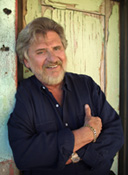 |
→ May 2007 Contents → Feature
|
Mary Calvert Finds Her Mission
May 2007
|
 |
|
The shooting of President Ronald Reagan changed Mary Calvert's life.
As a Liberal Arts student in Washington, D.C., in the early 1980s, Mary was wrestling with what she wanted to do with her life. As an art student, she loved photography, and tried various majors. First there was Travel and Tourism, because she wanted to see the world. Then she tried Mental Health because she wanted to save the world. Then she took a crack at Fine Art Photography, but realized she "would never make any money at it." Next she tried Commercial Photography, but that didn't work for her either. Then in March of 1981, John Hinckley shot the president. The Georgetown hospital that he was taken to was close by Mary's campus, and she took her camera and went to take a look. "I hung out with the news photographers," says Mary, "and that was it. Photojournalism was what I wanted to do. It was the best part of each of those majors rolled up into one neat package."

FREE AT LAST!: Graduating Midshipman and Marines from the United States Naval Academy cheer a Blue Angel fly-over at the start of their graduation ceremony at Navy-Marine Corps Stadium in Annapolis, Md.
"I like to tell people when I was in the Bay Area I covered natural disasters, then when I moved to Washington, I covered political disasters."
In 1998, she was invited to join the staff of The Washington Times as a general assignment photographer.

LOST DAUGHTERS: Women are an endangered species in India. "Raising a daughter," said an old Punjabi saying, "is like watering your neighbor's garden." In the last 20 years India has lost about 10 million girls to sex selection. Due to the devaluation of women and expensive dowries required by the groom's family, women are holding out for boy children. Sons are preferred in India because boys will be more prosperous and take care of their aging parents. They carry on the family name and are the ones to inherit family wealth. Girls are seen as a drain on family resources. Many women rely on illegal ultrasounds to determine sex, leading to the aborting of girl fetuses. The long-term effects are coming to fruition. Despite its status as one of the world's largest democracies, India is a country where women suffer a low status. A beggar woman shares the sidewalk with a stray dog while a man waves her away.
This year, her portfolio won her the Best of Photojournalism's "Photographer of The Year" award for small markets. In addition to her single pictures from general assignments, the judges singled out her three major photo essays, taken during a year of extensive travel abroad.
One essay shot in Africa, "Ethiopia's Trail of Tears," concentrated on women suffering from obstetric fistula. This is a condition where the mother is very young or malnourished, making the baby too large to pass through the body safely. "The mother winds up with a dead baby," says Mary, "and her family shuns her, her husband divorces her, and she has to live in isolation." There is a hospital run by Australians that can do a half-hour surgery to correct the condition. There is something so special about these mothers. They are so young, and so sweet, and some of them had been in labor for 10 days so it was a story that really meant something to me. With the coverage we were able to give it, we could actually help these women."

TRAIL OF TEARS: A patient walks through the 30-bed ward of the fistula center in Bahar Dar, Ethiopia.
A third story, "Hungry All the Time," was about a Maryland woman who suffers from a rare disease whereby the brain refuses to tell the body that it has eaten enough food.
Although Mary works in the classic photojournalist tradition, she understands the changes that are coming. "We were all worried when we started shooting color. People said 'Oh no! We can't shoot black and white any more.' It was a big shift, but now people are starting to use a lot of digital, shoot video and do sound, so we are on this cusp of a revolution, and I know a lot of people are worried about it. I'm a little bit worried about it. I haven't really learned about it yet, but I'm looking forward to learning it. It's so new. We all as photographers have this amazing opportunity to make it what we want it to be, before the writers and the editors get a hold of it, and make it something they want it to be. We have this amazing opportunity we need to jump on."
Mary would like to do more stories like the obstetric fistula project in the years ahead. Stories that make a difference. "We live in a troubled world, a complicated world, and I would just like to shine my light on little bits of it, to help them, and tell their stories. And I want to have fun. I want to challenge myself every day and learn from other photographers. That has taken me a long way in this business."
Mary Calvert is on the right track.
© Dirck Halstead
Editor and Publisher of The Digital Journalist
|
|
Back to May 2007 Contents
|
|